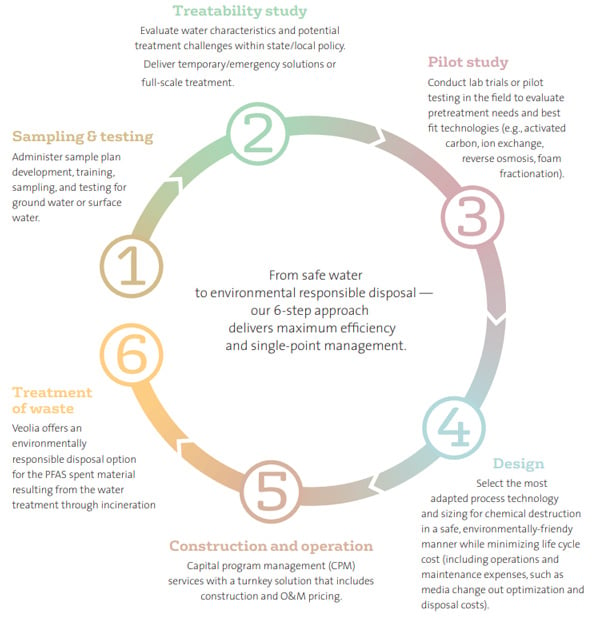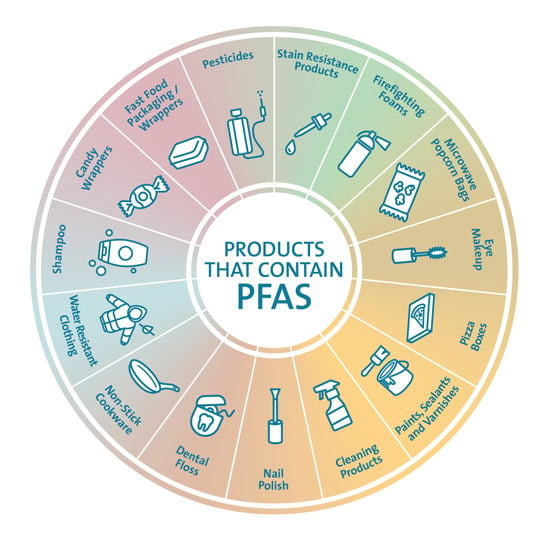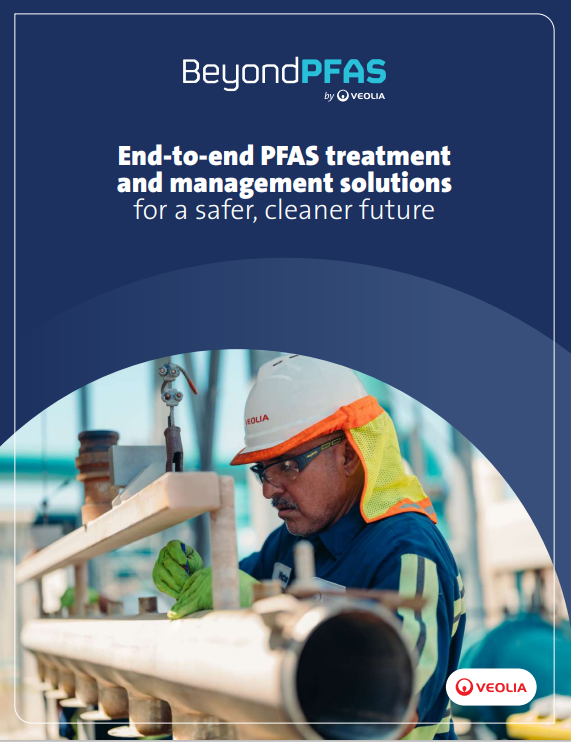They’re known as PFAS – technically, per- and polyfluoroalkyl substances – and they are rapidly becoming the one of the greatest environmental crises facing communities across the U.S. It is estimated that 98% of the U.S. population has these micro-pollutants in our bodies. Certain PFAS have been linked to higher rates of cancer and effects on reproductive health including developmental delays.
The family of PFAS, which include more than 4,700 man-made chemicals, have been circulating in our water, air and the ground beneath our feet for decades, but it’s only recently that the dangers some of these contaminants pose have become well-known or understood.
These chemical molecules can be found in a wide range of commonly used products, from cleaning products to electronics to non-stick cookware and water-resistant clothing. They are so widely used in the manufacturing of everyday products that they have been able to spread to water and wastewater systems, in soils and in the air.
In 2022, the Environmental Protection Agency (EPA) identified more than 120,000 facilities that may expose Americans to different types of PFAS.
What makes PFAS a concern?
Many PFAS chemicals do not break down easily. The molecular bonds in some of these materials are very difficult to separate. They do not break down over time. When PFAS chemicals move through the environment and contaminate drinking water and soils, they can build up in fish, wildlife and humans. Evidence links certain PFAS to negative health effects.
New health advisories for PFAS
In June 2022, the EPA issued new health advisories for PFAS, and the agency is expected to finalize regulatory limits for at least two PFAS compounds in drinking water in coming months. A health advisory is an identifiable limit established to provide all Americans, even the most sensitive populations, a protective margin to a lifetime of exposure in drinking water. In other words, health advisories are established based on exposure to substances for a lifetime and account for the most vulnerable individuals.
Health advisory levels (HALs) are intended to provide technical information that federal and state agencies and local officials can use to consider monitoring, treatment, and policy issues.
In 2016, the EPA issued HALs for PFOA and PFOS at 70 parts per trillion (ppt). The new EPA health advisory levels for these substances are set at lower levels: 0.004 and 0.02 ppt, respectively. The EPA also released final health advisories for two additional PFAS compounds, GenX and PFBS, for the first time in 2022.
What else are the federal and state governments doing to address PFAS?
Wastewater
At the moment, there are no federal regulations for PFAS in wastewater. The EPA is proposing monitoring requirements to track discharge of certain PFAS in stormwater and wastewater. The EPA will also be initiating three new rulemaking revisions to effluent limitations guidelines and pretreatment standards for:
- Organic Chemicals, Plastics and Synthetic Fibers category to address PFAS discharges from facilities manufacturing PFAS.
- Metal Finishing category to address PFAS discharges from chromium electroplating facilities.
- Meat and Poultry Products category to address nutrient discharges.
Hazardous waste
The EPA has proposed to designate two types of PFAS: PFOA and PFOS as hazardous substances under the Comprehensive Environmental Response, Compensation, and Liability Act (CERCLA), also known as Superfund. This classification would make responsible parties for sites contaminated with PFOA and PFOS liable for the full costs of recovery and enforcement actions under the Superfund Act. This may also impose new or different remedial actions for sites contaminated with these substances.
In 2022, the EPA made available $1 billion in grant funding through the Bipartisan Infrastructure Law to help communities that are on the frontlines of PFAS contamination. This will mark the first investment of at least $5 billion to be deployed this year that can be used to reduce PFAS in drinking water in communities facing disproportionate impacts. These funds can be prioritized in small or disadvantaged communities through actions such as technical assistance, water quality testing, contractor training, and installation of centralized treatment technologies and systems.
Additional resources are available through the Drinking Water and Clean Water State Revolving Funds and the EPA’s Water Infrastructure Finance and Innovation Act (WIFIA) program, particularly for large, capital-intensive projects. Environmental services companies like Veolia can help eligible communities apply for these funds and begin solving their water quality issues.
Multiple states have developed their own enforceable standards for drinking water that vary. Currently, there are maximum contaminant levels for nine states:
- Maine
- Massachusetts
- Michigan
- New Hampshire
- New Jersey
- New York
- Pennsylvania
- Vermont
- Maine
Emerging PFAS solutions
Despite the enormous technical challenges of remediating PFAS contamination, solutions are available for municipalities struggling with PFAS in their water systems. Whether it is a drinking water system that must ensure public health, a wastewater system that must adhere to environmental regulations, or an industrial plant that needs to secure the optimum performance of its treatment processes, resources, technology, and expertise can solve these technical challenges wherever they may occur.
One PFAS strategy is Veolia’s six-step, A to Z approach that involves:
1. Sampling and testing
Administer sample plan development, training, sampling, and testing for groundwater or surface water.
2. Treatability study
Evaluate water characteristics and potential treatment challenges within state/local policy. Deliver temporary/emergency solutions or full scale treatment.
3. Pilot study
Conduct lab trials or pilot testing in the field to evaluate pre-treatment needs and best fit technologies (e.g., activated carbon, ion exchange, reverse osmosis, foam fractionation).
4. Design
Select the most adapted process technology and sizing for chemical treatment in a safe, environmentally friendly manner while minimizing life cycle cost (including operations and maintenance expenses, such as media change out optimization and disposal costs).
5. Construction and operation
Following design and permitting of the proposed facilities, Veolia proceeds to construction, start-up and operation of the facilities. For our contract customers, Veolia offer's capital program management (CPM) services with a turnkey solution that includes construction and O&M pricing.
6. Treatment of waste
PFAS contaminants, which have been isolated and removed, can ultimately be handled through disposal at specialized waste management facilities. These solutions are just beginning to be available at various locations in the U.S., and technology is rapidly advancing.
As one example, Veolia offers an environmentally responsible disposal option for the PFAS spent material resulting from the water treatment through incineration at our facility in Port Arthur, Texas.
Here’s a look at Veolia’s end-to-end solution:

Though the U.S. and other parts of the world have only recently begun to appreciate the scope of the challenge around PFAS remediation, it is a challenge that must not go unmet. Innovation and access to emerging technologies will be key to this effort.
The information contained herein is based on the Veolia group's understanding and know-how of the scientific, regulatory and technical fields discussed herein as of the time of publication. No contractual undertaking or offer is made on the basis hereof and no representation or warranty is given as to the accuracy, completeness or suitability for the purpose of the relevant information.



